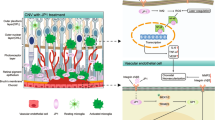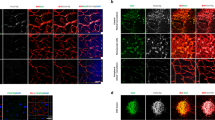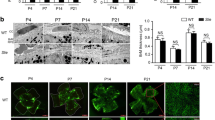Abstract
Purpose
Integrin ɑvβ3, an adhesion molecule overexpressed in neovascular endothelial cells, is involved in ocular angiogenesis. Integrin ɑvβ3-binding arginine–glycine–aspartic acid (RGD) peptide has been used to target and visualize new vessels. We explored the use of integrin ɑvβ3-targeted RGD peptide ([99mTc]IDA-D-[c(RGDfK)]2) for in vivo molecular imaging of choroidal neovascularization (CNV).
Procedures
To induce CNV in animals, the right eyes of C57BL/6 mice were treated with retinal argon laser photocoagulation. CNV formation was confirmed on immunohistopathological examination of retinal and choroidal tissues. To explore the association of integrin with angiogenesis, integrin mRNA expression in the retinal and choroidal tissues was measured using real-time reverse transcriptase-polymerase chain reaction. For in vivo imaging, mice were intravenously injected with [99mTc]IDA-D-[c(RGDfK)]2 and single-photon emission computed tomography (SPECT) images of [99mTc]IDA-D-[c(RGDfK)]2 were obtained before laser induction (baseline) and at 1, 3, 7, and 14 days post-induction. CNV-induced regional alterations were measured using radiotracer uptake count.
Results
Immunohistopathological examination revealed that CNV lesions showed intense fluorescein isothiocyanate (FITC)-D-[c(RGDfK)]2 immunofluorescence, in contrast to the normal retina and choroid. Retinal integrin mRNA expression peaked at day 1 following CNV induction. On SPECT images using [99mTc]IDA-D-[c(RGDfK)]2, the radio-uptake count in eyes with CNV was significantly higher than in normal controls on days 1–7 (all p < 0.05), with a peak at day 3 representing the highest angiogenic activity. Our preclinical data demonstrated that [99mTc]IDA-D-[c(RGDfK)]2 can detect CNV and its associated angiogenesis in an animal model of CNV.
Conclusions
SPECT imaging using an integrin ɑvβ3-targeted RGD peptide radiotracer may be a useful tool for in vivo functional molecular imaging of CNV.





Similar content being viewed by others
References
Congdon N, O'Colmain B, Klaver CC, Klein R, Muñoz B, Friedman DS, Kempen J, Taylor HR, Mitchell P, Eye Diseases Prevalence Research Group (2004) Causes and prevalence of visual impairment among adults in the United States. Arch Ophthalmol 122:477–485
Jager RD, Mieler WF, Miller JW (2008) Age-related macular degeneration. N Engl J Med 358:2606–2617
Lee P, Wang CC, Adamis AP (1998) Ocular neovascularization: an epidemiologic review. Surv Ophthalmol 43:245–269
Zarbin MA, Casaroli-Marano RP, Rosenfeld PJ (2014) Age-related macular degeneration: clinical findings, histopathology and imaging techniques. Dev Ophthalmol 53:1–32
Green WR (1999) Histopathology of age-related macular degeneration. Mol Vis 5:27
Group CR, Martin DF, Maguire MG et al (2011) Ranibizumab and bevacizumab for neovascular age-related macular degeneration. N Engl J Med 364:1897–1908
Noel A, Jost M, Lambert V et al (2007) Anti-angiogenic therapy of exudative age-related macular degeneration: current progress and emerging concepts. Trends Mol Med 13:345–352
Brown DM, Michels M, Kaiser PK et al (2009) Ranibizumab versus verteporfin photodynamic therapy for neovascular age-related macular degeneration: two-year results of the ANCHOR study. Ophthalmology 116 e55:57–65
Rosenfeld PJ, Brown DM, Heier JS, Boyer DS, Kaiser PK, Chung CY, Kim RY, MARINA Study Group (2006) Ranibizumab for neovascular age-related macular degeneration. N Engl J Med 355:1419–1431
Grunwald JE, Daniel E, Huang J, Ying GS, Maguire MG, Toth CA, Jaffe GJ, Fine SL, Blodi B, Klein ML, Martin AA, Hagstrom SA, Martin DF, CATT Research Group (2014) Risk of geographic atrophy in the comparison of age-related macular degeneration treatments trials. Ophthalmology 121:150–161
Yancopoulos GD, Klagsbrun M, Folkman J (1998) Vasculogenesis, angiogenesis, and growth factors: ephrins enter the fray at the border. Cell 93:661–664
Brooks PC, Montgomery AM, Rosenfeld M et al (1994) Integrin alpha v beta 3 antagonists promote tumor regression by inducing apoptosis of angiogenic blood vessels. Cell 79:1157–1164
Tucker GC (2003) Alpha v integrin inhibitors and cancer therapy. Curr Opin Investig Drugs 4:722–731
Kumar CC, Armstrong L, Yin Z et al (2000) Targeting integrins alpha v beta 3 and alpha v beta 5 for blocking tumor-induced angiogenesis. Adv Exp Med Biol 476:169–180
Luna J, Tobe T, Mousa SA, Reilly TM, Campochiaro PA (1996) Antagonists of integrin alpha v beta 3 inhibit retinal neovascularization in a murine model. Lab Investig 75:563–573
Friedlander M, Theesfeld CL, Sugita M, Fruttiger M, Thomas MA, Chang S, Cheresh DA (1996) Involvement of integrins alpha v beta 3 and alpha v beta 5 in ocular neovascular diseases. Proc Natl Acad Sci U S A 93:9764–9769
McDonald DM, Choyke PL (2003) Imaging of angiogenesis: from microscope to clinic. Nat Med 9:713–725
Gaertner FC, Kessler H, Wester HJ et al (2012) Radiolabelled RGD peptides for imaging and therapy. Eur J Nucl Med Mol Imaging 39(Suppl 1):S126–S138
Schottelius M, Laufer B, Kessler H, Wester HJ (2009) Ligands for mapping alphavbeta3-integrin expression in vivo. Acc Chem Res 42:969–980
Lee BC, Moon BS, Kim JS, Jung JH, Park HS, Katzenellenbogen JA, Kim SE (2013) Synthesis and biological evaluation of RGD peptides with the 99mTc/188Re chelated iminodiacetate core: highly enhanced uptake and excretion kinetics of theranostics against tumor angiogenesis. RSC Adv 3:782–792
Yoo JS, Lee J, Jung JH et al (2015) SPECT/CT imaging of high-risk atherosclerotic plaques using integrin-binding RGD dimer peptides. Sci Rep 5:11752
Lee MS, Park HS, Lee BC, Jet a (2016) Identification of angiogenesis rich-viable myocardium using RGD dimer based SPECT after myocardial infarction. Sci Rep 6:27520
Reich SJ, Fosnot J, Kuroki A, Tang W, Yang X, Maguire AM, Bennett J, Tolentino MJ (2003) Small interfering RNA (siRNA) targeting VEGF effectively inhibits ocular neovascularization in a mouse model. Mol Vis 9:210–216
Lambert V, Lecomte J, Hansen S, Blacher S, Gonzalez MLA, Struman I, Sounni NE, Rozet E, de Tullio P, Foidart JM, Rakic JM, Noel A (2013) Laser-induced choroidal neovascularization model to study age-related macular degeneration in mice. Nat Protoc 8:2197–2211
Brooks PC, Stromblad S, Klemke R et al (1995) Antiintegrin alpha v beta 3 blocks human breast cancer growth and angiogenesis in human skin. J Clin Invest 96:1815–1822
Brooks PC, Clark RA, Cheresh DA (1994) Requirement of vascular integrin alpha v beta 3 for angiogenesis. Science 264:569–571
Johnson LL, Schofield L, Donahay T, Bouchard M, Poppas A, Haubner R (2008) Radiolabeled arginine-glycine-aspartic acid peptides to image angiogenesis in swine model of hibernating myocardium. JACC Cardiovasc Imaging 1:500–510
Giani A, Thanos A, Roh MI, Connolly E, Trichonas G, Kim I, Gragoudas E, Vavvas D, Miller JW (2011) In vivo evaluation of laser-induced choroidal neovascularization using spectral-domain optical coherence tomography. Invest Ophthalmol Vis Sci 52:3880–3887
Haubner R, Wester HJ, Reuning U, Senekowitsch-Schmidtke R, Diefenbach B, Kessler H, Stöcklin G, Schwaiger M (1999) Radiolabeled alpha(v)beta3 integrin antagonists: a new class of tracers for tumor targeting. J Nucl Med 40:1061–1071
Lee KH, Jung KH, Song SH, Kim DH, Lee BC, Sung HJ, Han YM, Choe YS, Chi DY, Kim BT (2005) Radiolabeled RGD uptake and alphav integrin expression is enhanced in ischemic murine hindlimbs. J Nucl Med 46:472–478
Salehi-Had H, Roh MI, Giani A, Hisatomi T, Nakao S, Kim IK, Gragoudas ES, Vavvas D, Guccione S, Miller JW (2011) Utilizing targeted gene therapy with nanoparticles binding alpha v beta 3 for imaging and treating choroidal neovascularization. PLoS One 6:e18864
Ma L, Liu YL, Ma ZZ, Dou HL, Xu JH, Wang JC, Zhang X, Zhang Q (2009) Targeted treatment of choroidal neovascularization using integrin-mediated sterically stabilized liposomes loaded with combretastatin A4. J Ocul Pharmacol Ther 25:195–200
Wallig MA, Haschek WM, Rousseaux CG, Bolon B (2018) Fundamentals of toxicologic pathology. 3rd ed.: Elsevier Inc.
Funding
This study was supported by the Korean Research Foundation [grant numbers NRF-2014R1A2A2A01007980, 2016R1D1A1B03934724, and 2018M2A2B3A02071842] and the Korea Health Technology R&D Project through the Korea Health Industry Development Institute, funded by the Ministry of Health & Welfare, Republic of Korea [HI14C1072].
Author information
Authors and Affiliations
Corresponding authors
Ethics declarations
Conflict of Interest
The authors declare that they have no conflict of interest.
Electronic Supplementary Material
ESM 1
(PDF 253 kb)
Rights and permissions
About this article
Cite this article
Ahn, S.J., Lee, HY., Hong, H.K. et al. Preclinical SPECT Imaging of Choroidal Neovascularization in Mice Using Integrin-Binding [99mTc]IDA-D-[c(RGDfK)]2. Mol Imaging Biol 21, 644–653 (2019). https://doi.org/10.1007/s11307-018-1294-8
Published:
Issue Date:
DOI: https://doi.org/10.1007/s11307-018-1294-8




